
DAVID A. SCHORSCH & EILEEN M. SMILES AMERICAN ANTIQUES
For 2022 we will be presenting a specially curated booth of classic Shaker furniture juxtaposed with traditional American folk art, to be accompanied by a color-illustrated catalogue by David A. Schorsch entitled Parallel Visions: Shaker Design and American Folk Art, available at the show and as a flipbook on our website (schorsch-smiles.com), beginning on January 21. One of our favorite offerings will be this rare cherry and butternut work stand inscribed to Sister Juilan Scott, signed by the renowned Shaker craftsmen Orren N. Haskins (1815–1892) of Mount Lebanon, New York, circa 1863–1870. It is one of three known signed stands by Haskins, with the other two in the collection of Hancock Shaker Village.
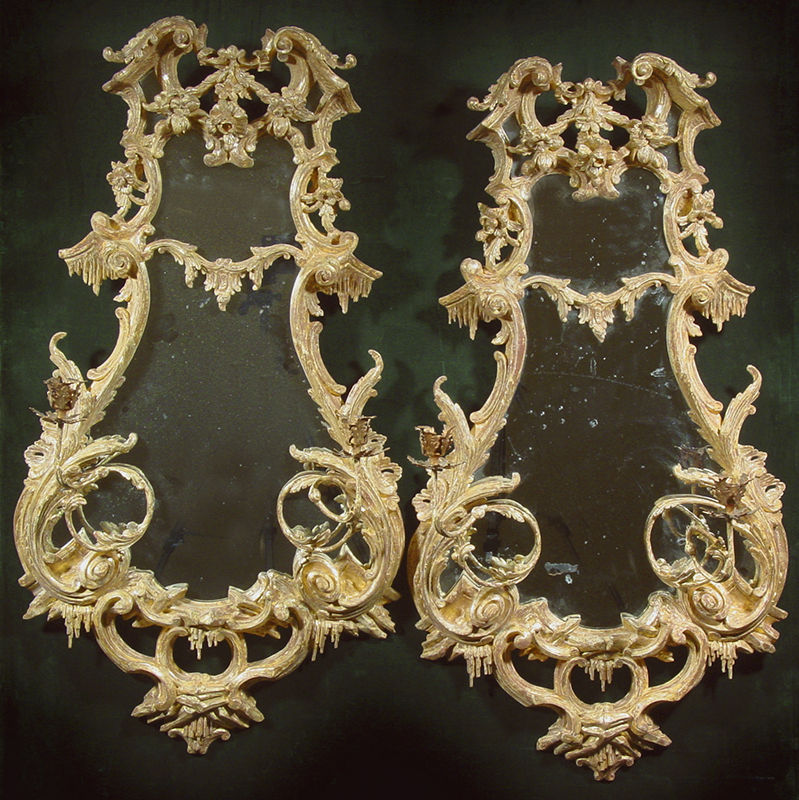
HYDE PARK ANTIQUES
This pair of George III gilt-wood girandoles, circa 1760, is a superb example of the full expression of eighteenth-century English rococo design. Originating in France and characterized by a move toward a lighter and airy approach, the rococo was a reaction to the prior baroque style, which often had a heavier appearance. The present pair is elaborately carved throughout with intertwined acanthus leaves, creating dramatic illusions of movement. The elaborate details, incorporating rockwork, scrolls, and swags, draw the eye around the double plates. The sense of continuity and complete design is further enhanced by conforming sinuous candle arms.
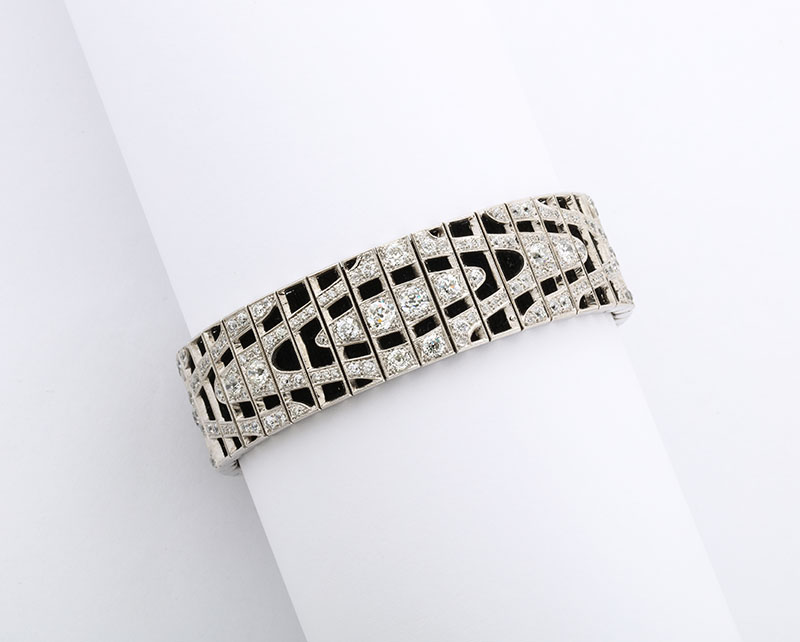
JAMES ROBINSON, INC.
The epitome of chic, this platinum and diamond bracelet exhibits the strength and purity of American expression during the mid-art deco period. The upper surface is pierced, segmented, and reticulated in a linear fashion that suggests moire silk or the concentric patterns on water into which a stone has been tossed. The face of the bracelet is finely milgrained, and the sides are a bridge to accommodate a band of black velvet, caged beneath. In design, the bracelet exemplifies stylized interpretation of curvilinear patterns within a clean-bordered line that is a hallmark of art deco. It is a stunning example of “less is more”!

DEBRA FORCE FINE ART
In 1953 George Tooker (1920–2011) moved to an old brownstone in Brooklyn Heights, where a rooming house across the street inspired his Windows paintings. There are eight numbered works in the series and nine others touching on the theme, to which the artist returned through the 1970s. The dramatic juxtaposition of light and shadow and the backlit arrangement of Window VIII evince the careful draftsmanship and detail found in the artist’s tempera paintings. The work, dating from 1966, is thought to be a memorial to Malcom X, who had been assassinated the year before, and whom Tooker admired for his civil rights work.
Window VIII was acquired directly from the artist by Henry Crapo, who knew Tooker from Hartland, Vermont, where the artist bought a house in 1958. It has remained in the Crapo family since 1967 and was exhibited at the Museum of Fine Arts, Boston that year. The painting was most recently included in the 2008–2009 retrospective Tooker exhibition co-organized by the National Academy Museum, the Pennsylvania Academy of the Fine Arts, and the Columbus Museum of Art in Ohio.

A LA VIEILLE RUSSIE
Primarily known for his surrealist paintings, Salvador Dalí (1904– 1989) was a multidisciplinary artist; among his many artistic endeavors, he designed jewelry, including this 18-karat gold brooch with pro les of Tristan and Isolde of about 1950 (diameter 1 ¾ inches). Seeking to revive jewelry as an art form, Dalí began collaborating with New York jewelry manufacturer Alemany and Ertman to bring his unique visions to life. Like his paintings, he applied his surrealist symbolism to his jewels, drawing inspiration from nature, religion, and mythology.
The twelfth-century legend of Tristan and Isolde is a subject Dalí returned to frequently, reinterpreting it in a variety of mediums, including sets and costumes for the ballet Mad Tristan, the print Le Phitre D’amour, and of course, jewelry. The Tristan and Isolde brooch features the gold star-crossed lovers facing a garnet and diamond chalice. The chalice refers not only to the story itself (a love potion contributes to their ill-fated romance), but in Dal ’s words, “the effluence of love possible between a man and a woman.”
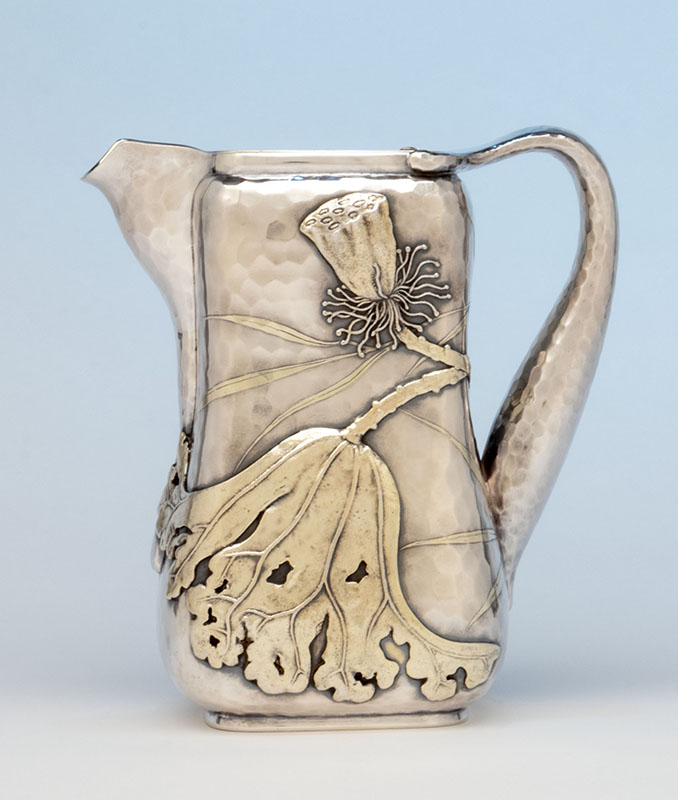
SPENCER MARKS, LTD.
This boldly designed pitcher features a stunning honeycomb- hammered body with a smooth, matte finish. All the decorative elements, including the naturalistic, sweeping grasses, and lotus flowers in various stages of bloom, are applied and engraved. Gilding makes the flora an even more dramatic aesthetic statement. On the bottom is an engraved rendering of a lotus plant by Charles Grosjean, who likely designed the pitcher. Beautifully engraved on one side are the initials “MEW” and on the underside, “M.E.W. Westinghouse,” for Marguerite Erskine Walker Westinghouse, wife of George Westinghouse, the famous inventor who purchased the patents for alternating current electric motors from Nicola Tesla.
The Westinghouses were some of Tiffany’s best clients, and this pitcher is similar to a tea set they owned with the same monogram and initials. Sold at Sotheby’s in 2006, the tea service brought $380,000 (we believe a record for an American tea set).
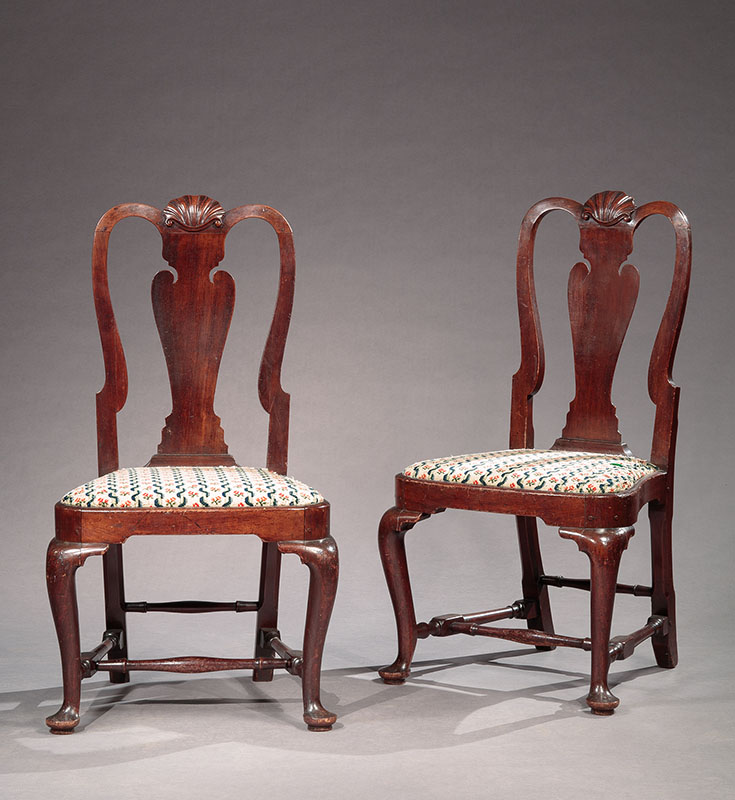
HIRSCHL & ADLER GALLERIES, INC.
Reverend Ebenezer Gay (1696–1787) of Hingham, Massachusetts, the original owner of these walnut chairs, was pastor of the Old Ship Meeting House, and, according to President John Adams, the father of Unitarianism as well as a loyalist. The chairs (probably Massachusetts, possibly Newport, Rhode Island) descended in Gay’s family for well over two hundred years. Sydney Howard Gay (1814–1888), Ebenezer’s great-grandson and fourth owner of the chairs, was a staunch abolitionist associated with Frederick Douglass, who ultimately landed in New York, becoming editor of the National Anti-Slavery Standard. He kept a “Record of Fugitives,” detailing escapees aided by the Underground Railroad, whose local activities were spearheaded by the Standard office. Sydney was a leader of the clandestine network responsible for the passage of several thousand slave escapees transiting through New York to safety in New England and Canada in the years before the Civil War. The chairs descended to his daughter, chair of the Staten Island Woman Suffrage Party and founder of the Staten Island branch of the American Red Cross, whose husband was the president of the New York City Board of Education. Their daughter, a patent-holding biochemist in immunology, owned the chairs before bequeathing them to her own philanthropist daughter, who sold them in 1986.
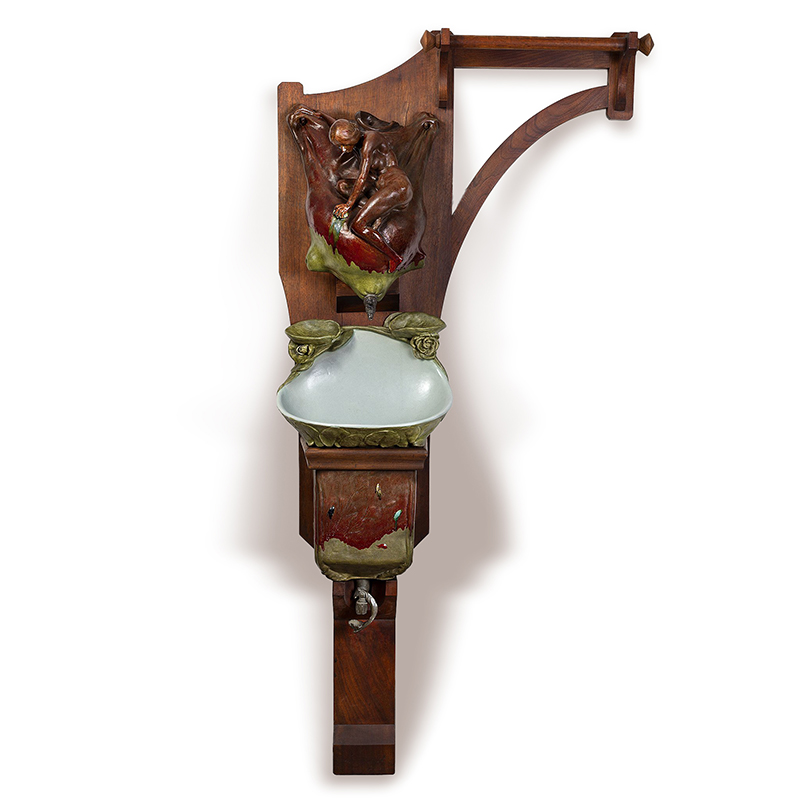
MACKLOWE GALLERY
We are presenting a very rare French ceramic fountain basin by Francois Rupert Carabin. He was considered one of the most brilliant sculptors working in wood in the art nouveau era. His work was a celebration of natural bodily forms and erotic postures, often hinting at the dangerous and threatening side of the psyche. This composition depicts a woman or nymph, who at first appears to be scrubbing blood from a large rock. On a closer look, however, one can discern the shape of a uterus in the top part of the fountain. The “blood” emanating it symbolizes femininity and, in the context of this narrative, sexuality. The composition is complex and dynamic, with gentle contours.
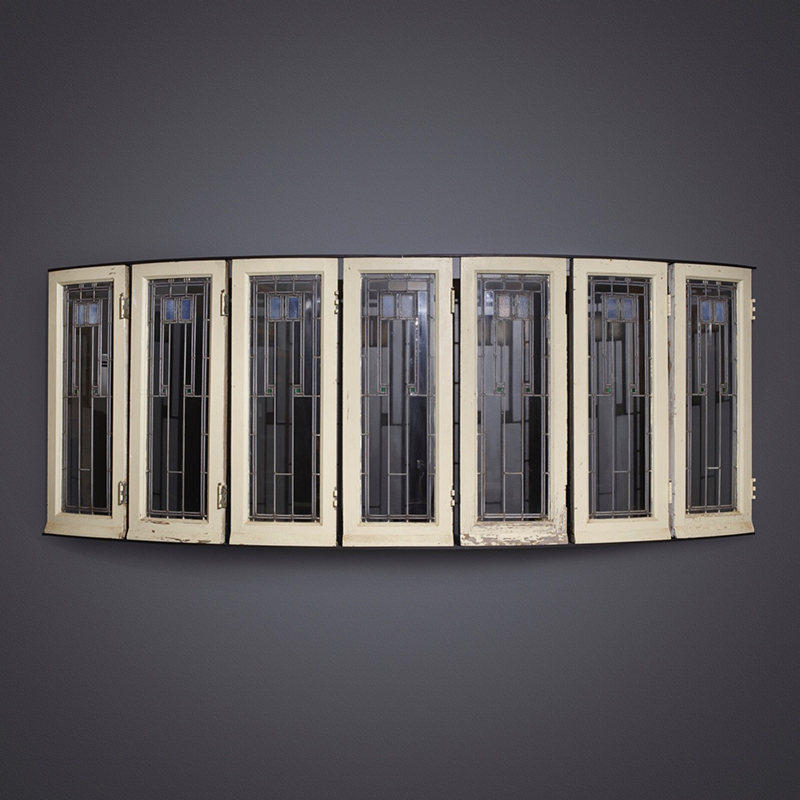
BERNARD GOLDBERG FINE ARTS
These rare leaded windows, still in their original frames, come from the Henry B. Babson house, designed by Louis Sullivan and built 1908–1909 (demolished in 1960). Babson, president of the Tobey Furniture Company, commissioned Sullivan to create his home in Riverside, Illinois, the suburb of Chicago planned by Frederick Law Olmsted (co-designer of New York’s Central Park) in the late nineteenth century. While the concept is attributed to Sullivan himself, it is likely that much of the detail was the work of Sullivan’s chief draftsman and ornamental designer, George Grant Elmslie (who left Sullivan’s practice in 1910, but continued to work with Babson, creating additions to and renovating the property through the 1920s). Regardless, the strict linearity of the windows, composed of variously sized rectangles and punctuated by delicate green glass squares, reveals the influence of Sullivan’s former assistant, Frank Lloyd Wright. It is fascinating that these strictly geometric windows decorated a project that otherwise reflects Sullivan’s signature Prairie style. The same window design was set into the Babson house’s notable second-story wooden loggia, projecting off the front elevation. Articulated by a colonnade of slender columns, arches, and lush, organically inspired fretwork, the loggia (save for its sleekly modernist windows) was among many details in keeping with a more ornate aesthetic.
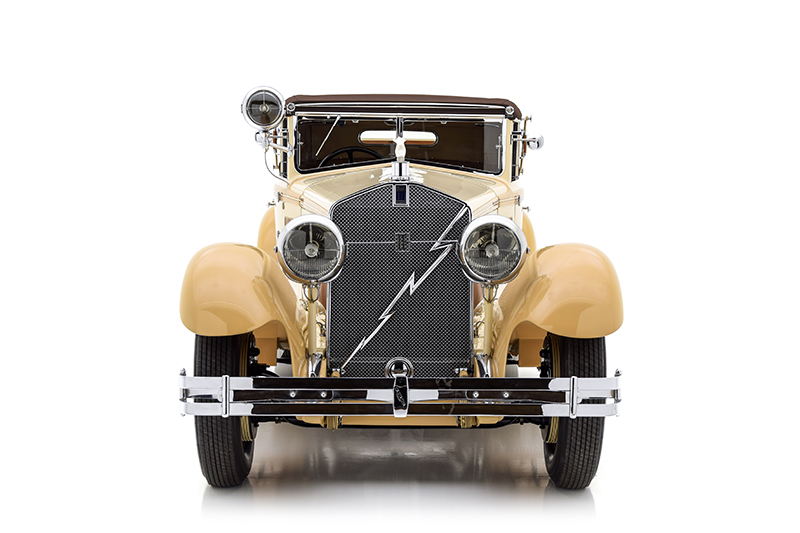
KELLY KINZLE ANTIQUES
The forward-thinking Isotta designers aimed the luxury 1930 Commodore Roadster at drivers, not chauffeurs; the “Super Sprint,” or SS, package enabled speeds in excess of 100 mph. This great piece of Italian engineering also incorporates luxury coachwork by Carrozzeria Castagna, known for its fashionable car bodies, elaborate interior appointments, and the finest cabinetwork, upholstery, and trim. The hood ornament is by Lalique. This model was first displayed at the prestigious Hotel Commodore Salon in New York in 1929 and was so popular that ten cars, including this one, were ordered. The model became wildly successful in America, especially in Hollywood. So when you see something so provocative that you can’t get it out of your mind, buy it. I did.
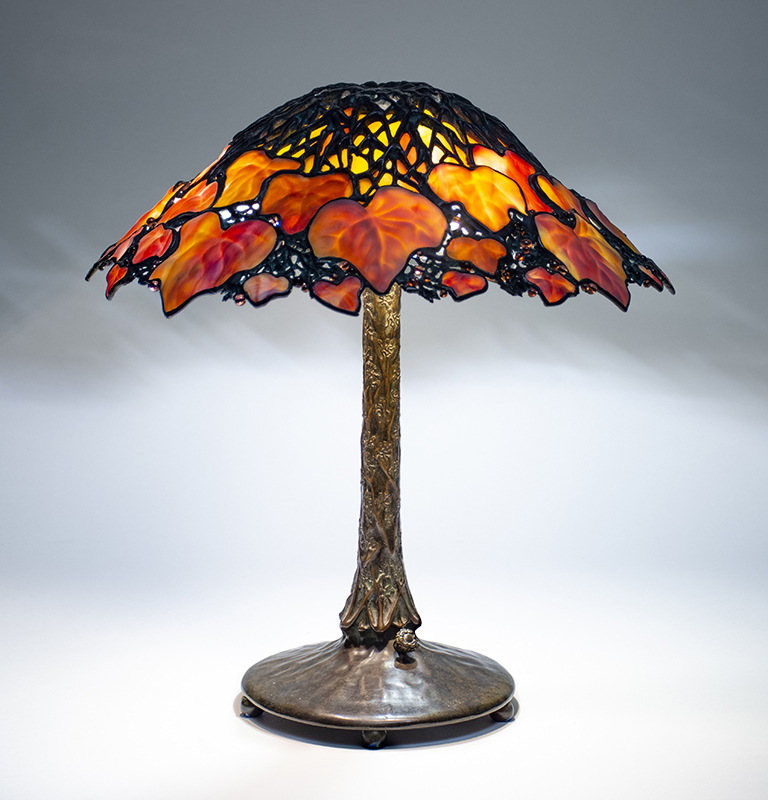
LILLIAN NASSAU
Believed to be the only extant example of the model, this complex Virginia Creeper table lamp is one of the rare Tiffany lamps designed as a representation of a living plant. We are thrilled to offer this masterpiece in leaded glass and bronze for the first time since April 1995, when it was acquired for the Louis C. Tiffany Garden Museum by famed Tiffany collector Takeo Horiuchi at Sotheby’s, New York, where it broke the then-record price for a Tiffany lamp sold at auction.
Previously, the lamp was in the collection of Houston businessman John W. Mecom Jr., and it was prominently displayed in The Masterworks of Louis Comfort Tiffany, the landmark 1989–1990 exhibition that traveled to major museums in the United States, including the Renwick Gallery of the Smithsonian American Art Museum in Washington, DC and the Metropolitan Museum of Art, New York.
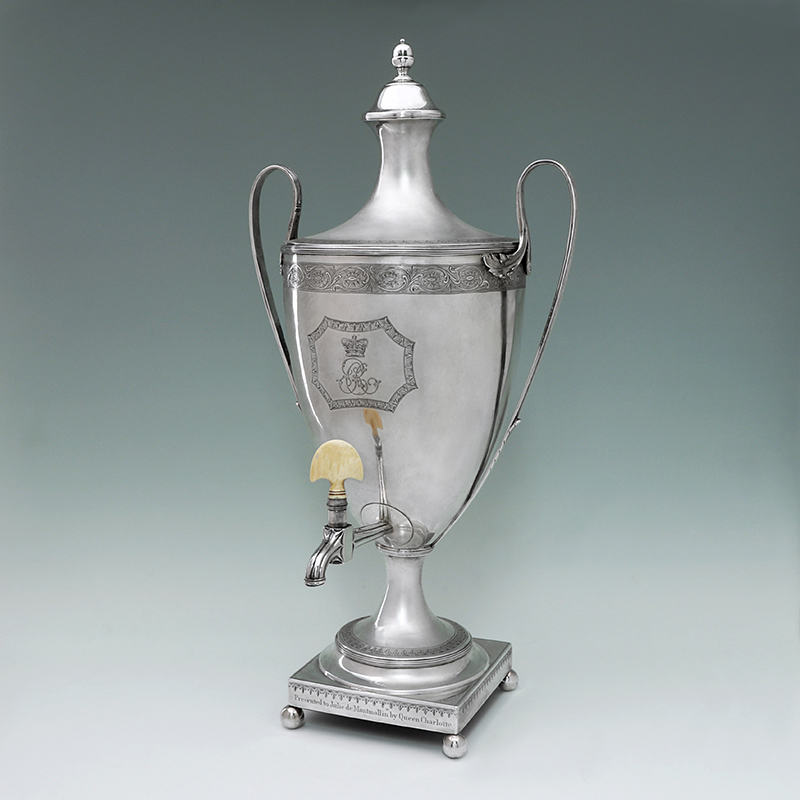
S. J. SHRUBSOLE
This elegant silver tea urn, made in London in 1790 by Edward Fernell, was a royal gift from Queen Charlotte, the wife of George III. She gave it to Julie de Montmollin, the needlework and French tutor to their younger daughters Sophia, Amelia, and Mary, who were known for their ne lacemaking, crochet work, and all kinds of embroidery. Unfortunately, the rest of their education was not of the same standard: “their handwriting was shocking, their knowledge of history, geography and botany skimpy, and their artistic and musical education sketchy.” Clearly we don’t expect to find gifts given to their other tutors!

THISTLETHWAITE AMERICANA
Emancipation, an oil on canvas signed by M. Horburg and likely painted in the mid-1860s, is a treasure of a reminder—and an early proof point—that while we have suffered harsh times in our history, Americans strive for equality for all.

NATHAN LIVERANT AND SON, LLC
With crisp Northern European light and exacting details, the ship portraits of Petrus Weyts (1799– 1855) of Antwerp, Belgium, were as prized by the ship owners of the nineteenth century as they are by today’s collectors. Created with oil paints on glass, this portrait of the schooner Ontario out of Newcastle, Maine, is dated 1846 and signed by the artist. The technique of reverse painting on glass requires a complex process of layering paints in reverse order from dark to light. Here, the expertly delineated ship’s rigging, sails, flags, and pennants are surrounded by lush water and a vibrant pink and turquoise sky. To the right of the Ontario is a view of Antwerp. In the 1840s, this thriving port city catered to ships of all nations, offering trade, supplies, and high quality artwork. Ontario was built in Newcastle in 1839 and featured a design prefiguring the revolutionary clipper ships that would soon rule the Seven Seas. Elegant, sleek, and fast, these sprightly ships covered the globe and changed the way shipping was done. The largest cargo possible was no longer the primary goal; more important was how fast one could get exotic goods from distant ports back to the bustling markets in the United States. The ship portrait of the Ontario is notable for the distinctive art of Petrus Weyts, as well as the important role Maine shipyards played in this historic transition.
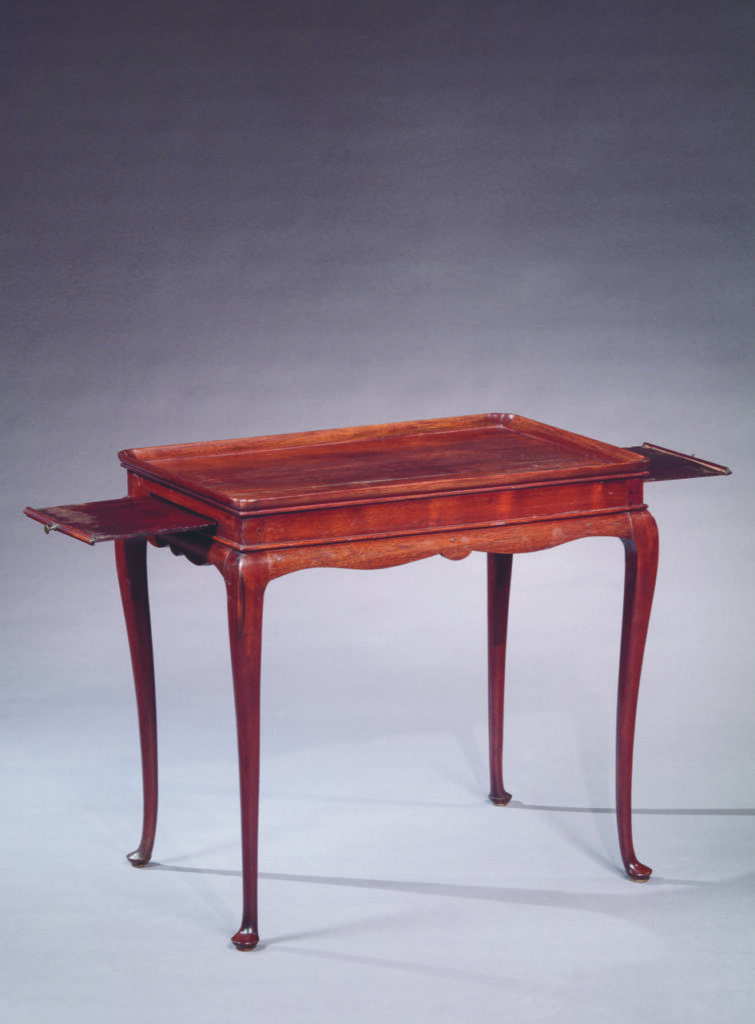
BERNARD & S. DEAN LEVY, INC.
T his Boston Queen Anne tea table with candle slides, c. 1750, is similar in the proportions of the skirt and identical in the construction of the slides and the top to a table that descended in the Bradlee- Fulton families that was illustrated in Albert Sack’s article “Regionalism in early American tea tables,” which appeared in The Magazine ANTIQUES in January 1987, page 252.

BARBARA ISRAEL GARDEN ANTIQUES
While we generally gravitate toward classical ornament, every now and then something quirky strikes our fancy. This totem figure is a case in point. Crafted in ciment fondu, or composition stone, it’s one of several expressive pieces created about 1970 by the venerable Dr. Gerald Moore (1926–2018), an Englishman of many talents and pursuits. Dr. Moore’s primary occupation was oral surgery, but he was also a prolific painter and sculptor, wartime actor appearing with Petula Clark in Medal for the General (1944), poet, children’s book author, and autobiographer. Additionally, he was the proprietor of Heathfield Park, a large exotic animal park and automobile museum. Dr. Moore’s artistic sensibility was shaped by trips to France and Italy in the late 1940s, and by 1950 he had exhibited and sold his first painting. His paintings were exhibited at the Scottish National Gallery in 1959 and, jointly with David Hockney’s works, at Heal’s Gallery in London in 1961. Dr. Moore’s deconstructed figurative style, which often included elements of the absurd, was self-described as “expressive experimentalism.” We’re not sure which we love mor—the curmudgeonly pathos written on this figure’s face, or the verve with which Dr. Moore lived his eminently adventurous life!
